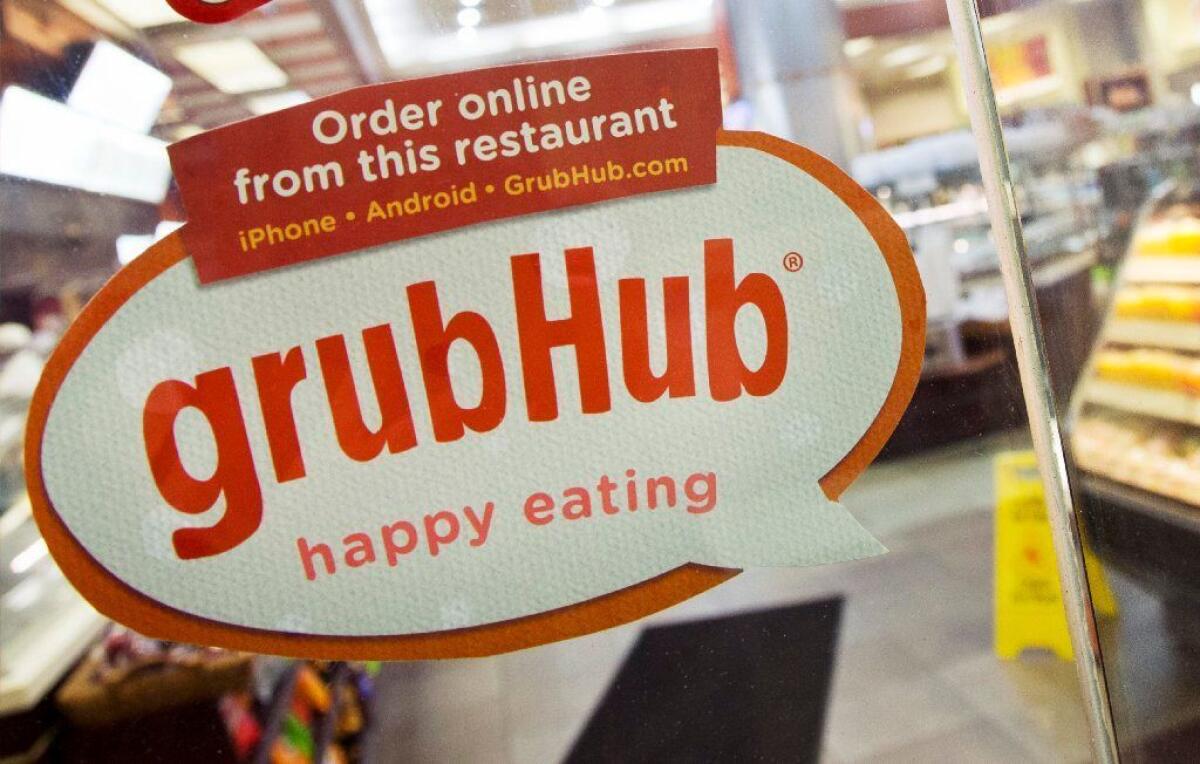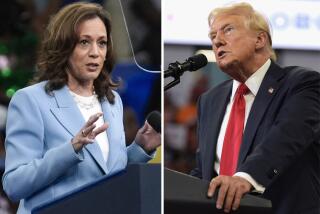Grubhub drivers say app change eats into tips, jeopardizing a usually generous season

A recent tweak to the food delivery app Grubhub that changes the way customers are prompted to tip delivery drivers has frustrated many workers, who say the change discourages tipping and is slashing their potential earnings.
Popular food delivery apps typically allow customers to tip drivers a percentage of their meal’s cost, with the default tip often ranging from 10% to 25%. Grubhub switched from that model Dec. 16 when the Chicago company rolled out new fees for customers in California to help cover the costs of driver benefits granted by voters in the state last month. The app now defaults to zero, or no, tip.
A new message also appears atop the prompt, saying customers may “Leave an optional tip on top of Driver benefits.” Drivers said the change is costing them and offsetting any gains from the newly added benefits.
On Christmas Eve, Los Angeles driver Audrey Wilson, 55, crisscrossed the city delivering meals, earning $1 or so on most orders, she said. A $10 tip from a resident of a palatial home just off Mulholland Drive was one of her biggest that night.
Wilson had recently restarted driving for the service after a months-long break. Because of the change in tip policy, she said, she plans to switch to a competitor, the food delivery platform DoorDash.
“I was digging the work. I got to make my own hours,” Wilson said. “But now it’s rare to get a tip over a dollar. It’s unbelievable.” She estimates she now makes 30% to 50% less daily than she did months before.
Grubhub spokeswoman Katie Norris said that California drivers for the platform are making 20% higher pay per order, including tips, since Proposition 22 came into effect, and that app users can still choose to leave a tip for their driver.
Proposition 22 — bankrolled by Uber, Lyft and other gig economy companies — won gig companies a carve-out from a state labor law that would have required them to classify their workers as employees and offer a full slate of benefits. As a concession to workers, the ballot measure outlined some new benefits, including a minimum earnings guarantee and a healthcare stipend for drivers who clock in a certain number of hours on the road.
Ride-hailing and food delivery platforms have since added fees to cover the cost of the new benefits: Grubhub added a flat fee of $1.50 per customer order. The company’s marketing language draws a link between the new fee and suggested tipping practices.
“In support of California’s Prop. 22, this payment helps guarantee minimum wage and healthcare benefits for our drivers so they don’t have to depend on tips,” reads a note on the app under an information tab explaining the new driver benefits fee.
Rival DoorDash slightly increased service fees for some California orders to fund new driver benefits, said DoorDash spokesperson Taylor Bennett. The company is also considering changes to some promotions such as DashPass, a subscription service that offers unlimited deliveries for a fee, that may also affect the price for some customers.
Uber spokesman Davis White said additional fees for customers of the ride-hailing giant will vary depending on the city. For example, since Dec. 14, each Uber Eats food delivery order has risen by 99 cents in Los Angeles and $2 in San Francisco.
The company has also tacked fees of 75 cents in Los Angeles and 30 cents in San Francisco on to rides, with the additional charge rising to $1.50 in more sparsely populated areas.
Gig economy companies have largely struggled to turn a profit, first as start-ups and increasingly as publicly traded companies. Proposition 22 saved them the costs of overhauling their approach to labor in California, a huge market.
Grubhub remains one of the few that had become profitable, and yet this year the company lost money — even during the pandemic, when food delivery became a more common habit because of restaurant dining restrictions. In June, European food delivery service Just Eat Takeaway agreed to buy Grubhub for $7.3 billion, a deal that will give it a foothold in the U.S.
Grubhub’s changed tipping prompt is a competitive move in the “arms race of food delivery,” in which pricing is key to gaining more customer share, said Dan Ives, an analyst at investment firm Wedbush Securities. With gig economy companies no longer worrying about having to classify their workers as employees instead of contractors, he said the food delivery market is likely to see more changes, as customer pricing and driver satisfaction become even more competitive.
“In a competitive market for drivers, California drivers are choosing to deliver for Grubhub more than ever before and now have more stability with guaranteed earnings before tips,” Norris, the company spokeswoman, said in a statement. “We are always tweaking our product to maximize value created for drivers, diners and restaurants. Diners continue to have the ability to leave a tip for their driver, including through the custom tip feature.”
Workers said the new benefits don’t offset the loss in income from tips, especially this time of year, as people tend to tip generously around holidays. Many workers for food-delivery and ride-hailing platforms decline to be identified by full name, saying they fear being reprimanded professionally for criticizing their employers’ policies.
Two Grubhub drivers who described their earnings to The Times, including by sharing work logs and receipts, said the default-tip change has significantly reduced their tip income. For them, the lost tips have so far offset gains from new Proposition 22 benefits, including a guaranteed earnings minimum that is reliant on a specific measure of hours worked. It has prompted some drivers to reconsider how many hours they put in, and whether work for the service is worth it at all.
One of them, Janell, a driver in the Central Valley, had researched various food delivery companies before settling on Grubhub because it seemed to offer the best pay.
Janell said she usually accepts more than 95% of the delivery orders she receives to keep her “premier driver” status, which gives her priority in scheduling work hours and larger orders. Her calculus has changed in the absence of big tips.
On Dec. 20, she delivered 15 orders and earned $28.73 in tips, far less than her usual average for a comparable number of deliveries. She had made $79.13 in tips on 13 orders Nov. 29. Accepting every order, big and small, and driving for hours through the thick winter fog is no longer paying off, she said. “I think customers are being bamboozled into thinking Grubhub is paying us a lot more,” she said.







